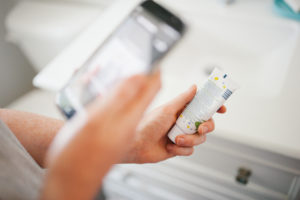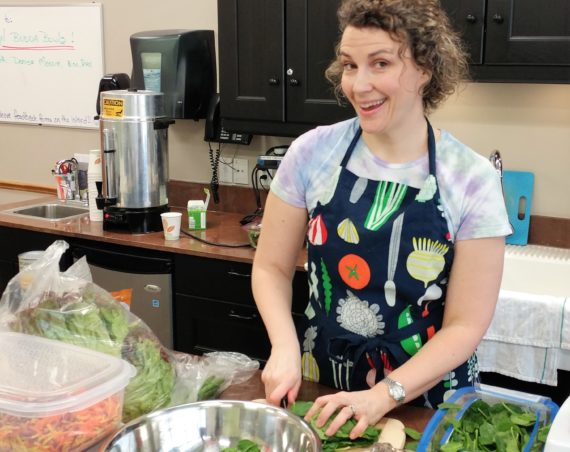Creating a healthy home environment is such an important part of wellness and while it can feel overwhelming, time-consuming and expensive, it truly doesn’t have to be! We all want to make healthy, environmentally-friendly choices for ourselves and our families but knowing how and where to get started can be a problem. To help us simplify and take easy steps that will make our homes safer, healthier and “greener”, we connected with Emma Rohmann. Emma is an environmental engineer and founder of Green at Home. She passionately uses her expertise to provide people with research-based info and practical tips that will help reduce exposure to toxins linked to chronic disease, infertility, obesity and more. Emma’s #1 goal is to leave people feeling energized to tackle a home detox with confidence!
We chatted with Emma to learn about what makes our indoor air even more toxic than outdoor air, the potential impacts of chemicals on our health, and her top 3 tips for making healthy, non-toxic changes to our homes that will help save our money, our time and our health!
 WEHL: Tell us a little about yourself and what inspired you to become interested in wellness.
WEHL: Tell us a little about yourself and what inspired you to become interested in wellness.
ER: Hi! My name is Emma Rohmann and I’m a mom of two kids (7 and 4 years old), environmental engineer, and founder of Green at Home. My wellness journey began in university, where I learned how much we were putting down our drains that couldn’t be removed by water treatment plants. I also started reading up on our food system and didn’t like what I was learning.
So, as a university student I switched to green cleaners (back when there weren’t as many good options as there are now), ate organic where possible and became vegetarian (that change only lasted for a few years).
After school, I began my 10 year career as a green building consultant. I learned about the impact our indoor environments have on our health and I became even more passionate about making healthier choices at home because of it.
WEHL: What is “Green at Home” and where did it all begin?
ER: When I had my kids, I began to wonder if I was doing enough to protect them from toxins. And truthfully, I secretly wanted to learn that it didn’t matter and I could just. stop. worrying.
I started researching on my 2nd mat leave, and ended up more confused than when I started. But I was also more certain than ever that it did matter. All my research pointed to one conclusion: that serious health issues are being caused by toxins in our homes.
I was also acutely aware of my family history of breast cancer, the painful and irregular periods I suffered with as a teenager, and my asthma that appeared surprisingly in university while living in student housing. All of which can be linked with environmental exposures.
So I decided I had to create a plan to get me out of the constant feeling of overwhelm.
Now my mission is to help moms and moms-to-be confidently reduce toxins at home, giving them peace of mind that they’re doing everything they can to support their family’s health – without overwhelm, a lifestyle overhaul, or wasting time and money on products that don’t work. I also help health and wellness experts incorporate environmental health into their practice to better address one of the root causes of disease.
WEHL: We’ve heard it said that our indoor air is more toxic than outdoor air. Tell us a little about this and what can contribute to making our indoor air toxic.
ER: You’ve heard correctly! The US EPA estimates that indoor air quality is 2 – 5 times more polluted than outside air. This is especially true in new homes that are sealed tightly (as they should be for energy efficiency) and in the winter when windows are closed up.
Indoor air pollution is caused by building materials releasing chemicals slowly over time (off gassing), household cleaners, room sprays and air fresheners, flame retardants and stain repellents released from furniture and décor, off gassing foam mattresses, and more.
 WEHL: What are the top chemicals to watch out for and what is their potential impact on our health?
WEHL: What are the top chemicals to watch out for and what is their potential impact on our health?
ER: After extensively researching common toxins in our homes for the past three years, my focus has turned to hormone disrupting chemicals. These have been shown to act on our bodies at much smaller doses than other chemicals, so the low exposures we see from everything like our skincare and cleaning products, plastic containers and cans, and even our drinking water, are adding up to cause a wide range of health issues.
Hormone disrupting chemicals are linked with weight gain, infertility, asthma, autoimmune disease, and more.
WEHL: How does switching to non-toxic household and beauty products help us and how does it help the planet?
ER: We used to think that the small amounts of toxins in household and beauty products weren’t a problem. And if you’re looking at a single product in isolation, that’s true. But we’re exposed to hundreds (or thousands) of toxins in a day.
Your body is designed to detoxify, but we’re putting too many toxins in us for our detoxification systems to handle properly. When they get overloaded, that’s when we see health problems. It’s impossible to eliminate your exposure, but when you switch to non-toxic products that are under your control, you’re reducing your overall body burden of toxins. Combined with reducing stress, getting more sleep, drinking more water, and other healthy lifestyle habits, you can support your body to better cope with the toxins you can’t control.
Switching to non-toxic products reduces your impact on the planet as well. Whether it’s the landfill or down the drains into our lakes and oceans, when products are used up, their ingredients end up in the environment. We’re finding microplastics in fish and flame retardant chemicals that have been banned for decades in polar bears. What we use at home matters.
WEHL: Making healthy, non-toxic changes to our home can feel overwhelming and time-consuming. Where do you recommend people start first?
ER: First, take a breath. There is so much information out there, much of it conflicting and fear-mongering, that it can be easy to feel overwhelmed. Start with a few small steps that are easy for you to make and give you quick wins.
Here are a few tips to get started – most of them cost less and save time too!
- Stop using air fresheners and room sprays. Light a match to neutralize bathroom smells instead. Switch to high quality essential oils in a diffuser that you run occasionally if you need to have a scent in your home.
- Give up fabric softener, dryer sheets, and scented laundry detergent. Alternatives for static reduction are wool dryer balls, reduce drying time, or put vinegar in the fabric softener dispenser instead (just be sure to flush it out of your old stuff first).
- Don’t heat food in plastic. Heating food in plastic releases hormone disruptors like phthalates into your food. If you use plastic containers to store food, transfer it onto a plate before you warm it up.
WEHL: In your opinion, are air cleaners a good addition to our household? If so, do you have any tips for what to look for?
ER: Air purifiers can help those with severe allergies and multiple chemical sensitivity significantly. They may also be beneficial if you’re moving into a new build home and don’t have time to let it off-gas fully before moving in. Not all air purifiers are created equal though, so it’s important to dig deep and not take the marketing language at face value. I’ve created a Top 5 Air Purifiers List to help with your search, which you can find here.
WEHL: Non-toxic and green products can be more expensive or are often perceived to be more expensive. What are your thoughts on this and how can we make affordable, healthy purchase decisions?
ER: At face value, yes, they are more expensive. However, many green products are more concentrated so they last longer, decreasing costs over the long-term. We’re also conditioned to conventional marketing, which tells us we need a different product for every little thing. In reality, skincare and cleaning products can and should be multi-purpose, which also reduces costs.
My favourite cost-saving strategy is to make my own cleaners, even though I’m not typically a DIYer. They work really well, are super easy, and cost effective. You can see the recipes I use to clean my own home here.
You can also avoid wasting money on products that aren’t actually as healthy as the marketing wants you to think by checking the ingredients using tools like the Think Dirty App and EWG’s Guide to Healthy Cleaning. I’ve also put together lists of cleaning and body care products that are commonly thought to be green, and reveal how healthy they truly are. You can grab the cleaners list here, and body care list here.
 WEHL: How can “Green at Home” help families and health practitioners who want to reduce their exposure to toxins?
WEHL: How can “Green at Home” help families and health practitioners who want to reduce their exposure to toxins?
ER: I’m passionate about helping health and wellness practitioners and coaches more effectively support their clients to reduce toxins at home. You can get client handouts on fertility, babies and children, hormone disrupting chemicals, and fatigue by clicking here.
I also help families reduce toxins throughout their home through my online program, Your Healthy Home, and 1:1 consultations. To get clear on your own home detox goals, and learn my 3 step process to avoid overwhelm while creating a healthy home, you can book a free Home Detox Audit call here.
Connect with Emma and Green at Home:
- Web: www.greenathome.ca
- Email: [email protected]
- Wehl Platform: @erohmann
We invite you to join our all-in-one healthy lifestyle app at Wehl.com!




2 Comments
Sherika
We normally hear how all these household products are bad for you but you hardly ever get any practical alternatives. I loved that this article highlighted ways we can make our homes clean in a greener way.
Jennifer
I completely agree, Sherika! I appreciated the practical alternatives Emma suggested as well! I recently started using dryer balls and so far so good! Glad you enjoyed the read! 🙂